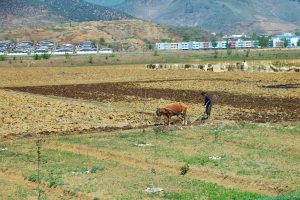North Korean food prices are rising, with rice in Pyongyang reaching 6,300 North Korean won per kilogram on September 15. This is the highest rice price since early October 2023.
Rice prices in other areas have risen to levels similar to those in Pyongyang. On September 15, a kilogram of rice sold for 6,400 won at a market in Sinuiju, North Pyongan province, and 6,580 won at a market in Hyesan, Ryanggang province. In Hyesan, the price of rice has been above 6,000 won since the end of March.
In mid-September, the price of rice in North Korean marketplaces was at an all-time high.
The average price of rice in Pyongyang, Sinuiju and Hyesan is currently 6,426 won. This is 83 won higher than the average of 6,343 won in mid-September of 2023, which itself was higher than the average of previous years.
Meanwhile, the price of corn at marketplaces is also on the rise. A kilogram of corn sold for 3,200 won in a Pyongyang marketplace on September 15, up 6.7 percent (200 won) from the price at the beginning of the month on September 2.
The price of corn in Sinuiju and Hyesan increased by a similar amount. The survey showed that corn cost 3,300 won in Sinuiju and 3,310 won in Hyesan on the same day.
Normally, the price of food in North Korea continues to rise until early October, when the year’s corn crop begins to reach the markets. But the current price of food in North Korean marketplaces is already on par with last year’s high.
The main reason that food prices continue to rise in North Korean markets appears to be that less rice and corn are being delivered to the markets. This, in turn, is due to a combination of factors: an undersupply of domestically produced food and less food being imported from overseas.
“The current rise in food prices in North Korean markets is linked to a shortage of supply and rising exchange rates. The unprecedented high exchange rates may be behind the reduced food imports,” said Cho Chung-hee, director of Good Farmers’ research institute and an expert on North Korean agriculture.
Selling large amounts of imported grain on the market can lower food prices, but the current amount of imported goods does not appear to be enough to have much of an impact, Cho explained.
According to a Voice of America report in late July, citing Chinese customs officials, the value of North Korean rice imports from China in the first half of the year was only one-tenth of the value for the same period in 2023.
While the North Korean authorities operate grain warehouses in every region, these warehouses are not supplied with enough grain, and the gap between their prices and market prices continues to widen. As a result, the state-run grain stores do not appear to be helping to stabilize food prices.
“When the state-run grain stores were first established, they sold rice and corn for 20-30 percent less than market prices, but now the state-run stores are often only 300 won (per kilogram) cheaper than market prices,” said Cho. “Many North Koreans are also turned off by the poor quality of products in the state-run stores. Such factors are also behind the rise in prices in North Korean markets.”
This article first appeared in Daily NK, which contacts multiple sources inside and outside North Korea to verify information. The Diplomat was not able to verify the claims independently.

































